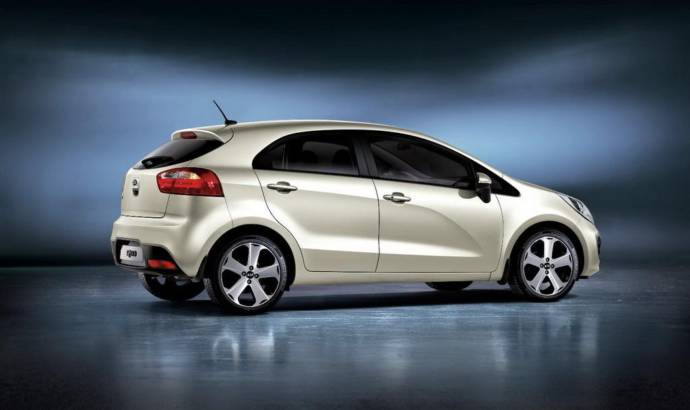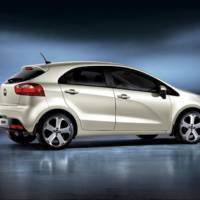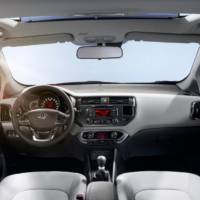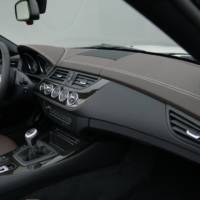The Korean automaker has revealed detailed information with the 2012 Kia Rio as the new generation model has been unveiled in Geneva.
Available with a choice between 3-door and 5-door body-styles the 2012 Kia Rio is 22 mm longer, 22 wider, 15 mm lower than the previous generation, and its wheelbase has also been extended by 70 mm to 2,570 mm.
A weight saving program has also been applied to the 2012 Kia Rio which will also offer its customers the possibility of choosing between four efficient 3-cylinder and 4-cylinder engines, with power ranging from 70 to 109 PS, base-line CO2 emissions from 85 grams per Km and fuel consumption figures as high as 88.3 mpg (combined UK rating).
The 2012 Kia Rio also comes with improvements to the steering, suspension and braking system have also been made plus the car comes with electronic
stability control, six airbags and ‘active’ front seat head restraints and a new system called
Emergency Stop Signal as standard.
The 5-door version goes on sale this September while the 3-door will be launched in early 2012.
For much more details information, check out the official press release below.
Kia press release :
Kia’s all-new fourth-generation Rio, revealed at the 2011 Geneva
Motor Show, boasts a bold and distinctive personality, bringing the
latest model into line with the rest of Kia’s striking design-led
product range.
Tasked with the difficult job of improving upon the international
sales success of the previous generation model, Kia’s engineers and
designers have created a new Rio which appeals to consumers’ aesthetic
tastes. However, new Rio will also drive sales through its low running
costs and class-leading CO2 emissions – with target figures for the model range starting at just 85 g/km.
Since its launch in 2005, global sales of the third-generation Rio
have totalled more than 860,000 units. It was the company’s third
best-selling vehicle in overseas markets during 2010 with sales of more
than 219,000 units, sales in the UK total 52,626 units.
The new Rio model is longer by 20 mm, wider by 25 mm, and lower by
-15 mm and features a wheelbase extended by 70 mm to 2,570 mm – greatly
enhancing passenger space and cargo capacity.
Manufactured for the first time with a choice of 5-door and 3-door
bodystyles, the new Rio is set to completely redefine its position and
Kia is confident of capturing a larger share of the growing B-market
segment.
To lower fuel consumption and help achieve Rio’s class-leading
emissions, Kia engineers have carried out an extensive programme to shed
weight across a broad range of components. As a result, although new
Rio is a significantly larger car than the third-generation model with
extra equipment, its weight-gain has been kept to a minimum.
The 5-door version of new Rio will go on sale in the UK from
September with the all-new 3-door model on sale from early 2012. Both
versions will be manufactured exclusively at Kia’s Sohari plant in
Korea.
‘Premium presence’ for compact new car
This new car is no evolution of its predecessor, it is a revolution.
The bold and distinctive personality of the new Rio represents a
complete departure from its predecessor and fits perfectly into the
revitalised new family of Kia products.
Viewed head on, new Rio has its own unique interpretation of the Kia
corporate grille which is integrated with the front lamps to create a
new twist on the Kia family look. In this latest form, the Kia logo now
sits above the grille. Below the grille, the treatment of the front
bumper and spoiler again shows signs of the Kia design DNA. In profile,
the ratio of body to glass and the car’s strong wedge form give Rio a
dynamic stance.
The Rio shows its connection with the Sportage, too, through its
strong and stable rear, flowing C-pillar and dominant high shoulder.
The coupe-like roof-line contrasts dramatically with the rear bumper and
gives a power and solidity to the rear view.
This bold but elegant appearance is strengthened by the distinctive
feature line which adds tension to the flanks and accentuates the
dynamic stance of the car. The careful balance of window graphic,
wheelbase and overall proportion give Rio a refined and premium
presence.
To maximise the impact of Rio´s striking appearance is a fresh new
palette of 10 body colours. Kia’s colour and trim team have developed a
spectrum of exclusive colours for Rio which underline its stylish
character.
With the introduction of the new Rio, the Kia product portfolio has
just taken the next important step towards becoming a family of vehicles
which has an attractive and coherent brand style but still manages to
retain individual product character.
Sophisticated and spacious interior
To complement the striking exterior, Rio’s interior design has also
been transformed, with a clean sophisticated theme. The concept follows
the corporate Kia interior philosophy with the characteristic
horizontal instrument panel, accentuating the feeling of width and
space.
As in other recently-launched Kia models, the signature interior
architecture – with its ‘three cylinder’ instrument cluster, precise
instrument graphics and clear functionality – has been retained. New
for Rio, however, are the centrally-located toggle switches, which are
neatly integrated into the central heater unit, and control some of the
secondary functions.
The sophistication of this interior concept is also reflected in the
breadth of trim options which give the car a genuine premium feel. The
bespoke feel of the interior underlines the new focus for Rio as a
mature and compact premium car.
The current trend towards downsizing of vehicles which is being seen
across Europe means that cars in the B-segment require more refinement,
more features and higher quality but above all more choice and
distinctive design is in demand.
The radically-new Rio is Kia´s answer to these new market conditions,
and numerous ‘big car’ comfort and convenience features will be offered
to consumers when new Rio goes on sale in Europe.
Optional features available on new Rio cars for the UK market will
include smart-key entry system, RDS radio CD player with MP3
compatibility plus AUX, iPod and USB connections, Bluetooth®
handsfree (with voice recognition available from December 2011),
climate-control air-conditioning, heated front seats and LED daytime
running lights.
The new Rio’s cabin is more spacious. The base of the windscreen is
moved forwards by 156 mm and up by 18 mm, while the 70 mm longer
wheelbase and 25 mm wider bodyshell bring space benefits for all
occupants and luggage capacity. Front legroom is increased by 45 mm,
front headroom by 8 mm.
The boot space is 100 mm wider and the capacity is now 288 litres – a
7% improvement over the previous model. The backrest of the rear seat
is split 60/40 for maximum versatility. Users can fold the backrest
down, to create an almost flat-floored load area.
Cabin storage includes a larger, 15-litre glove box, a larger centre
console with 3-litres of extra capacity and pockets to hold a 1.5-litre
bottle in the front doors and a 0.5-litre bottle in the rear doors.
Four highly efficient engines with 70-to-109 ps output
In the UK the new Rio will offer customers a choice of four highly
efficient three- and four-cylinder engines – with a 70-to-109 ps power
range – and a CO2 base-line rating from just 85 g/km, plus fuel consumption as high as 88.3 mpg.
In many countries, diesel power is the preferred option in this
segment and Rio will be available with two versions of Kia’s ‘U2’ power
unit – both fitted with 16-valves and a Waste Gate Turbo. The 1.4-litre
generates 90 ps and 216 Nm of torque, while the 1.1-litre produces 70
ps and 162 Nm. Both engines deliver maximum torque from just 1,750 rpm.
Buyers who prefer their new Rio powered by petrol can select from a 1.4-litre Gamma or 1.25-litre Kappa engine.
A well-proven power unit in the Kia line-up, the updated ‘Gamma’ has
friction-reducing modifications and dual Continuously Variable Valve
Timing, to achieve a responsive performance and competitively modest
fuel consumption. With maximum output of 109 ps and peak torque of 136
Nm, this engine powers the fastest Rio – accelerating to 100 kph (62
mph) in 11.5 seconds and reaching a top speed of 181 kph (112 mph).
Kia’s advanced ‘Kappa’ family of engines – also appearing in the New
Picanto at the Geneva Show – features dual CVVT, a cast aluminium block,
off-set crankshaft, maintenance-free timing chain and low-friction
‘beehive’ valve springs. These technologies significantly improve
efficiency and reduce exhaust emissions. The 1.25-litre engine in Rio
delivers 85 ps and 117.8 Nm of torque, while achieving fuel economy of
58.8 mpg.
Rio models will have a CO2 rating of 94-to-124 g/km. In
the UK, these figures can be further reduced by specifying Kia’s
optional fuel-stretching ISG technologies (automatic stop-start,
advanced alternator control, upgraded starter motor and low-rolling
resistance tyres) – available on selected UK models.
Equipped with ISG, Rio’s emissions will range from 85-to-114 g/km, so
the two diesel models (under 100 g/km) qualify for local
emissions-based tax savings, where available. For these models, fuel
economy will range from 88.3 to 58.8 mpg, contributing to lower running
costs.
Standard transmission for both diesels and the larger petrol engine
will be a six-speed manual gearbox, while the 1.25-litre 85 ps petrol
engine has a five-speed box. A four-speed automatic gearbox will be
available as an option on the 1.4-litre 109 ps petrol engine.
Improved stability, ride and refinement
Developed from the previous model, the New Rio’s suspension and
running gear has been engineered to carry over that popular car’s
responsive handling while improving stability, ride quality and
refinement – in line with heightened customer expectations.
The electric power-assisted rack and pinion steering now features a
combined torque/angle sensor to protect against side wind gusts. It is
geared to require 2.8 turns (lock-to-lock) and the steering wheel is
adjustable for both height and reach.
Mounted on a sub-frame to isolate road shocks, the MacPherson strut
front suspension is largely unchanged, with small alterations to
accommodate the new model’s longer wheelbase, wider track and different
weight distribution.
The Coupled Torsion Beam Axle at the rear is stiffer therefore
reducing under-steer and the strength of the connection between the
trailing-arms and the stub-axles is doubled, improving stability. Wheel
travel is increased by 10 mm and the geometry is improved to reduce
bump-steer and deliver a more compliant ride.
An all-disc braking system – with 256 / 262 mm (front / rear)
diameter discs – is standard on all new Rio models fitted with
Electronic Stability Control. The performance of the braking system is
supported by ABS anti-lock, electronic brake force distribution and
emergency ‘brake assist’ systems.
Comprehensive ‘active’ and ‘passive’ safety
For new Rio, an all-new bodyshell was created using a higher
percentage of high-strength steel than the third-generation model,
enhancing strength and rigidity. Special attention was given to
strengthening the engine-bay longitudinal side members, floor panel side
members, floor level cross-member between the B-pillars and the
transverse dashboard bulkhead.
Kia’s engineers are confident that new Rio will achieve a 5-Star
safety rating in EuroNCAP crash tests, following the top ratings scored
by cee’d, Venga, Soul, Sportage and Sorento.
In the UK, standard safety equipment will include electronic
stability control, six airbags and ‘active’ front seat head restraints,
to protect against whiplash injury in a rear impact. A new system called
Emergency Stop Signal will be available for additional safety. To
alert following drivers that the car is slowing rapidly, sensors detect
when the driver is braking suddenly and hard, and then automatically
flash the brake lights three times.
Measures to minimise NVH include increasing the rigidity of the car’s
bodyshell structure with a stiffer steering column support bracket,
reinforced panels within the C-pillar, strengthened rear fascia and
increased stiffness for the inner and outer skins of the tailgate, plus
larger hydraulic mountings for the engine and transmission to dampen
vibrations.
Engines
| 1.4-litre | 1.25-litre | 1.4-litre | 1.1-litre | ||
| Fuel type | Petrol | Petrol | Diesel | Diesel | |
| Displacement | cc | 1,396 | 1,248 | 1,396 | 1,120 |
| Power output | ps | 109 @6000 rpm | 85 @ 6000 rpm | 90 @ 4000 rpm | 82 @ 6400 rpm |
| Torque output | Nm | 136 @ 4200 rpm | 118 @ 4000 rpm | 216 @ 1750 rpm | 94 @ 3500 rpm |
| Engine details | Gamma 4-in-line, DOHC, four-cylinder with dual CVVT | Kappa 4-in-line, DOHC, four-cylinder with dual CVVT | U2 4-in-line, DOHC four-cylinder with WGT | U2 3-in-line, DOHC three-cylinder with WGT |
Transmission
| Transmission type | Six-speed manual | Five-speed manual | Six-speed manual | Six-speed manual |
| Four-speed auto |
Suspension, steering and braking
| Front axle | Fully independent subframe-mounted MacPherson struts with coil spring, gas-filled shock absorbers and anti-roll stabiliser bar. |
| Rear axle | Semi independent CTBA with separate coil springs and gas-filled shock absorbers |
| Braking system | Ventilated front discs 256 x 22 mm, and solid rear discs 262mm x 10mm with ABS and EBD and ESC |
| Steering | MDPS electric power-assisted, rack-and-pinion, 2.8 turns lock-lock |
| Wheels | 15 inch x 5.5J/ 16 inch x 6.0J/ 17 inch x 6.5J |
| Tyres | 185/65 R15 / 195/55 R16 / 205/45 R17 |
Dimensions and weights
| Wheelbase | mm | 2,570 |
| Overall l / w / h | mm | 4,045 / 1,720 / 1,455 |
| Front / Rear overhang | mm | 805 / 670 |
| Front / Rear track | mm | 1,520 / 1,525 |
| Head / Leg / Shoulder room front | mm | 1,015 / 1,112 / 1,350 |
| Head / Leg / Shoulder room rear | mm | 960 / 790 / 1,324 |
| Luggage capacity (VDA) | litres | 288 |
| Turning circle | metres | 10.4 |
Performance and fuel consumption
| 1.4-litre | 1.25-litre | 1.4-litre | 1.1-litre | ||
| Petrol | Petrol | Diesel | Diesel | ||
| Acceleration (0-100 kph)* | seconds | 11.5 | 13.0 | 14.2 | 16.4 |
| Maximum speed* | kph | 181 | 167 | 171 | 161 |
| Fuel consumption** Fuel consumption w. ISG** |
mpg | 54.3 58.8 |
58.8 65.7 |
68.9 80.7 |
80.7 88.3 |
| CO2 CO2 (with ISG) |
g/km | 124 114 |
114 104 |
109 94 |
94 85 |
| Fuel tank capacity | litres | 43 | 43 | 43 | 43 |
* Figures stated are manufacturer’s estimates
** Figures are for combined cycle






